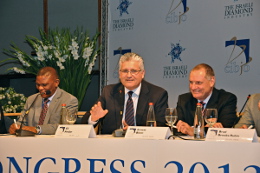The opening session of the 2013 CIBJO Congress in Tel Aviv concluded with a panel discussion that looked at the role of the jewellery industry in promoting economic development in the countries where diamonds are mined.
The discussion was moderated by Eli Avidar, Managing Director of the Israel Diamond Institute, the host of the 2013 congress, who also is a member of CIBJO’s President’s Council.
The discussion started out by looking at the issue of whether the industry was simply defending its reputation by doing what appears to be the minimum necessary to defend itself in the eyes of the world’s consumers.
“Today, the beneficiation policy that was initiated in South Africa has been adopted in one form or another in the other countries of Southern Africa,” Mr. Avidar said, during his introduction. “There are functioning diamond cutting industries in a number of African nations, financed in part by diamond companies in the major cutting centres, including Israel, Belgium, India and the United States. The Diamond Trading Company is in the process of transferring the bulk of its operation from London to Botswana. Whatever way you look at things, there have been some very significant changes.”
“But there still are questions to be asked.,” he continued. “What is the industry’s obligation, and is it being met successfully? Has the emphasis been predominantly on the measures being taken to defend the reputation of products, and not on what need to be done so that the diamond achieves its full developmental potential?”
Brad Brooks-Rubin, the Special Advisor for Conflict Diamonds in the Bureau of Energy, Economic, and Business Affairs at the U.S. Department of State, said Corporate Social Responsibility should look beyond just defending the industry and its products, and take a more holistic approach that promotes business success throughout the supply chain.
He also said there were many standards, with the gold industry, for example, having four to five organisations each with different standards. In addition, there are OECD guidelines for multinational enterprises.
Mr. Brooks-Rubin said that artisanal mining was a critical sector which was open to widespread exploitation. The industry must engage with other groups to make the sector open to long-term development.
Commenting on the situation in South Africa, World Federation of Diamond Bourses President Ernie Blom said the country’s large production of diamonds, gold and platinum had enabled the development of a jewellery industry but sales were mostly to tourists. The industry had also suffered from imports of cheap jewellery. He added that the government’s beneficiation strategies had not always led to the results required. He also said that although modern technology plays a large role, many companies still use old-fashioned techniques.
Jacob Thamage, Director of the Diamond Hub at the Botswana Ministry of Mining Energy and Water Resources, said there were still gaps in the knowledge of the diamond sector in his country and elsewhere in Southern Africa. “We have a young population with many unemployed people who are well educated and that leads to great frustration. They see their jobs being exported.”
Ambassador Sisa Ngombane, South Africa’s Ambassador to Israel, said his country “had not always done the right thing and we need to try and spread the benefits of beneficiation across the population. Beneficiation needs investment, and we need more foreign participation.”
Andrei Abramov, Chief of the NGO section of ECOSOC, the United Nations Economic and Social Council, said sustainability was key and there are big challenges facing the world. There are 1.5 billion people living on $2 a day and one million artisanal workers living on $1 a day.
There are around one million child labourers in gold mining, which is extremely dangerous and with extremely low pay. In addition, there is environmental degradation. “Gold mining creates terrible mercury poisoning problems. Leaks of cyanide contaminate the environment. I know CIBJO is working on security, but mining is dangerous due to workplace injuries from mine collapses and other dangers. The profits do not benefit all levels of society.,” he stated.
“Natural resources create the opportunity for corruption which not the fault of industry but good governance is needed. Companies can assist governments. There is a great deal of social responsibility on the shoulders of the companies. “The Kimberley Process is excellent and stabilized the situation in many countries, but it is a regulatory body not a development body,” he said.
Akiva Caspi, Vice President of Marketing and New Business Development at Sarin Technologies, said there are big challenges for emerging cutting centres compared with mature centres. “The way to close the gap is by using technology to enable people in new centres to get the same value and with the same profitability. We want to close the gaps quickly.”
Master diamond cutter Gabi Tolkowsky closed out the session, stating that it was important not to lose sight of the jewellery industry was about. “Throughout today I have noticed that one word has not been mentioned,” he stated, and that is ‘beauty.’ That, ultimately, is what we create,” he said.

